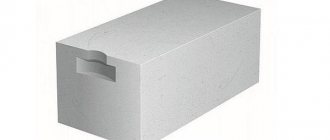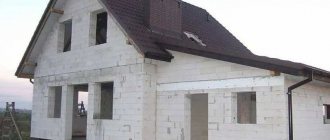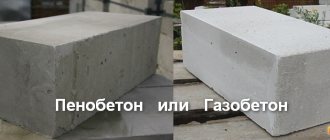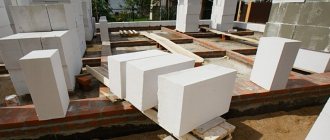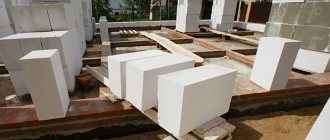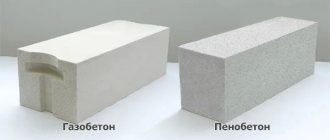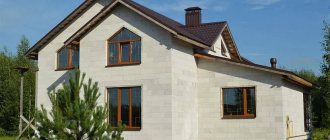Manufacturers and craftsmen offer many ready-made solutions for the implementation of various projects in the private, urban and industrial sectors. Let's consider what is better: aerated concrete or expanded clay concrete for building a house. Let's get acquainted with the characteristics of each material and conduct a comparative analysis according to various criteria. After reading the article, it will be easier to communicate with specialists in order to get the optimal result for a particular case.
A house made of aerated blocks before finishing work Source sdelai-lestnicu.ru
Aerated concrete
For the production of building materials, cement binder, lime, quartz filler and clean water are used. To create a porous structure, an aluminum gas former is added to the composition. Blocks are made using autoclave technology under the influence of hot steam and high pressure or without the use of a furnace.
The recipe for each manufacturer is approximately the same:
- Portland cement M400 – 90 kg;
- lime – 35 kg;
- purified sand with a fraction of 2 mm – 375 kg;
- water without impurities – 300 liters;
- aluminum powder – 0.5 kg
It is possible to add functional additives, but their content is kept to a minimum. This is justified by the peculiarity of the technology, which involves active chemical processes.
Classification of aerated concrete is based on density (D):
- 300 – brittle, with low thermal conductivity;
- 400 – thermal insulation, suitable for the construction of doorways;
- 500 – structural, relevant for the construction of houses up to two floors;
- 600 – durable, in demand for ventilated facades;
- 700-1200 – universal material for foundations, walls and ceilings.
Autoclaved aerated concrete Source arsvest.ru
Technical characteristics of aerated concrete blocks are shown in the table below:
| Characteristics | Meaning |
| Coefficient of thermal conductivity | 0.088-0.21 W/m*K |
| Compressive strength class | 0,75-7,5 |
| Average strength | 10-98 kg*s/sq.cm |
| Vapor permeability | 0.14-0.25 mg/m*h*Pa |
| Shrinkage | 0.3 mm/m |
| Flammability class | NG |
The physical parameters are standardized, but custom-made blocks can be manufactured. Thus, the length of products for partitions is 625 mm. For load-bearing walls, the width is in the range of 200-300 mm, the thickness is from 200 to 500 m. In general, samples with parameters in a wide range are found on trading floors.
The advantages of aerated concrete are as follows:
- low weight, which eliminates the use of lifting equipment or equipment;
- strict geometry with a smooth surface, which allows you to save on adhesive and leveling solution;
- the flat surface explains the dense masonry with seams of 3-5 mm, which minimizes the risk of cold bridges;
- inertness to fire, fungus and mold;
- versatility regarding application and architectural solutions, since the material is easy to process.
Laying aerated blocks Source twimg.com
The main disadvantages come down to the porous structure. Because of this, the material has relatively high water absorption and fragility. To fasten heavy objects to aerated concrete walls, you have to use metal or chemical anchors. Another disadvantage is that for masonry it is permissible to use only specialized glue, which is important to distribute evenly over the entire working surface of the block.
Benefits of blocks
- The large size of the blocks makes the laying process simpler and significantly speeds up the construction of walls.
- Significant material savings compared to brick construction.
- Correct geometric shape. Smooth forms allow you to save on solutions, finishing materials and adhesives, and also significantly reduce the load on workers.
- When laying blocks, instead of cement mortar, you can use special glue. It is used very sparingly, lays down thinly, not allowing cold to subsequently penetrate through the seams (which is typical for cement seams).
- Optimal parameters of thermal and sound insulation. The porous structure of the block allows for excellent thermal and sound insulation, even when laid in one block.
- Environmental friendliness. Environmentally friendly, harmless substances used for the production of gas, foam, expanded clay concrete blocks do not emit harmful substances under the influence of external factors (when moistened, heated).
- Light weight allows you to save on the foundation when building private houses. It is enough to make it shallow, tape or columnar with a grillage.
- There is no need to involve heavy construction equipment and high-class specialists. Even a non-specialist can carry out the work of laying blocks.
- The cost of blocks is affordable.
Expanded clay concrete
To produce the material, expanded clay of different fractions and Portland cement, purified sand, and water without impurities are used. Additionally, sawdust, ash and functional additives can be added. The proportions are determined by the purpose of the finished blocks and mortar. Production directly on the construction site without special equipment is allowed.
The classification of expanded clay concrete mortar is carried out according to grade strength (M). The way the products are used depends on this indicator:
- 50 – ebb of partitions and walls;
- 75 – formation of load-bearing structures in monolithic design;
- 100 – filling the screed;
Expanded clay concrete screed Source mirbetona.info
See also: Projects of houses made of expanded clay concrete
- 150 – production of structural blocks;
- 200 – formation of block elements and floors;
- 300 – construction of roads and bridges.
Based on density, there are three types of composites:
- Sandless . Instead of quartz, fine gravel is added to the composition. The material is relevant for floors, walls and ceilings in low-rise construction.
- Porous . The group of expanded clay concrete blocks is represented by thermal insulation, structural and wall samples with different densities: up to 700, up to 1200 and up to 200 kg/cub.m, respectively.
- Dense . A less popular option with a higher content of Portland cement. It is characterized by high strength.
Another criterion for classification is volumetric mass. The table shows the technical indicators of the types:
| Name | Strength | Weight per cubic meter |
| Heavy | 25 MPa | 1200-1400 kg |
| Easy | up to 32 MPa | 800-1000 kg |
| Particularly light | 7.5-40 MPa | up to 600 kg |
Standard sizes of block products from manufacturers vary depending on the purpose. For partitions – 188*190*390 mm, for walls – 188*90*390 mm. The thermal conductivity of thermal insulation samples depends on the density of the samples and is 0.19-0.9 W/m*K.
Expanded clay concrete blocks Source vkfaces.com
The advantages of the material are as follows:
- low thermal conductivity with high strength;
- low weight due to light expanded clay;
- admissibility of on-site manufacturing;
- environmental friendliness;
- variety of finished products in terms of density, strength and smoothness of the front surface.
The disadvantages include three points. The material absorbs moisture well, which precludes the use of block masonry as an independent structure. Despite the low thermal conductivity, additional insulation of walls is required in regions with a temperate climate and in the north. The third disadvantage is the lack of ideal geometry. More mortar for laying and leveling is required than for smooth analogues.
Production cycle overview
Since we have already compared the qualities and properties, it is worth briefly considering the manufacturing features of both materials and analyzing the level of complexity and amount of labor costs. Perhaps, when choosing, this will become a powerful argument.
Features of foam concrete manufacturing
Foam concrete can be produced in several ways:
- Classic technology;
- Barotechnology;
- Dry mineralization method.
Classic technology is the most common.
The stages of work are as follows:
- A foaming agent is introduced into the cement mortar;
- The prepared solution is poured into molds;
- Semi-finished products are subjected to stripping (when manufactured in a single layer, they are pre-cut into standard sizes);
- Processed in an autoclave or kept for 28 days using a non-autoclave production method.
The dry mineralization method differs in that the ingredients are mixed dry.
The barotechnology method involves supplying foam through high pressure, without the use of a foam generator. The method is often used during continuous production on a construction site.
The equipment can be used in several types:
- Mini line. Differs in the minimum daily volume of production. Suitable for home production and small businesses.
- A stationary line is more expensive; you can choose the equipment yourself. Productivity is higher, labor costs are lower.
- The conveyor line is the most automated. It is used in large-scale production, the daily production volume can reach 200 m3. Features minimal human intervention.
Products made using this line are of higher quality and geometrically smooth.
Production of expanded clay concrete: review of equipment and step-by-step analysis of the work process
To produce expanded clay concrete, you will also need certain equipment.
The lines can be either fully automated or partially manual (mini-line). A standard set of machines, tools and raw materials suitable for home use includes:
- Concrete mixer;
- Vibropress;
- Cement, sand, water, expanded clay and plasticizer (liquid soap can be used);
- Container in the form of a bucket or trough.
The sequence of work looks like this:
- The solution is mixed. Water is poured in first, followed by all the ingredients;
- The finished solution should have a consistency similar to sour cream;
- The next step is molding. To do this, you will need vibrating compaction equipment, which, using vibration, compacts the solution.
- Excess mixture is removed with a special knife;
- The metal plate with the products is dried for several days, after which they are unmolded;
- Like foam concrete, expanded clay concrete products need to gain strength within 28 days.
- It is also worth mentioning the presence on the construction industry market of a combined material called expanded clay foam concrete.
- It is manufactured using modern technology. The essence of the method is as follows: components in the form of water, expanded clay, cement and foaming agent are sequentially loaded into the mixer. The latter is supplied in the form of a solution by spray.
- This innovation relates to the production technology of panels for walls made of expanded clay foam concrete.
- The main goal of such production is to obtain a finely porous solution structure with closed pores, which undoubtedly led to a decrease in thermal conductivity and density, due to an increase in the amount of air in the solution and a uniform distribution of cells.
Recommendations for the production of expanded clay foam concrete products
Briefly about the profitability of production of both materials, possible prospects
If we talk about profitability, then producing expanded clay concrete and foam concrete is economically profitable.
The result largely depends on a number of factors, which include:
- Features of the region, including purchasing power;
- Investments in business, type of equipment and productivity;
- Speed of sales of finished products;
- Business expenses, number of employees and much more.
In any case, for proper planning, it is recommended to first draw up a business plan that will take into account all possible income and expenses and will be able to predict the approximate outcome.
Even if we assume that the cost of one m3 of expanded clay concrete is about 2,200 rubles, and it can be sold for 3,200, then, provided that 30 m3 are produced per day (this is a small volume) and sold, you can earn 900,000 in a month. This, you see, good income.
A set of budget equipment will cost approximately 800,000. It is easy to calculate that in an optimistic scenario, it can pay for itself in 1-2 months.
Comparative characteristics
When deciding whether it is better to use a gas block or expanded clay block to build a house, you need to consider several criteria. Thus, from the point of view of constructive use, a composite with expanded clay can be used on a construction site for screeding, monolithic structures and the formation of individual elements. The composition with aluminum powder is relevant only for the manufacture of blocks.
Blocks made of aerated concrete and expanded clay concrete Source twimg.com
Structure
Cellularity, which determines the low weight of materials and water absorption, is characteristic of both blocks, but is explained by different reasons. In the case of aerated concrete, this is the content of aluminum gas-forming agent. In expanded clay concrete, the porous structure is created by expanded clay. In total, the air content in each case is at least 70%.
Strength
When choosing whether expanded clay concrete or aerated concrete is better in terms of load-bearing capacity, preference should be given to a universal composite. Moreover, even hollow blocks with expanded clay in their composition have greater mechanical endurance than solid foam concrete products of similar density.
Block products made of aerated concrete are acceptable for the construction of houses up to 15 meters high on three floors. More durable analogues are suitable for the construction of buildings of 10-12 floors. But even this load-bearing capacity is not enough to lay the foundation and plinth. This is additionally explained by strong water absorption, which under constant load will lead to rapid destruction of structures.
Construction of walls from expanded clay concrete monolith Source ytimg.com
Differences in how materials are produced
To choose the most suitable building material, you need to familiarize yourself with all its features in advance. Aerated concrete differs in its properties from expanded clay concrete. Walls, load-bearing and internal partitions of houses are often built from these materials.
Expanded clay block is used in construction as a monolithic material. Hollow and solid expanded clay concrete is offered on the market. The use of aerated concrete in monolithic structures is rarely used. Produced gas blocks can vary in size.
The composition and production technology of these materials are very different, but both of them belong to the class of cellular concrete. Aerated concrete is a porous material containing a huge amount of air bubbles. The raw materials used for its production differ from the materials from which expanded clay concrete is made.
Aerated blocks are made from the following types of materials:
- sand;
- cement;
- lime;
- aluminum powder.
The process of the appearance of air bubbles associated with gas formation involves the use of aluminum powder. As a result, the produced building material is porous. Aerated concrete, like expanded clay concrete, is produced under a certain brand.
The production of expanded clay concrete is carried out from the following types of materials:
- sand;
- cement;
- expanded clay;
- water.
During the manufacturing process, the entire mixture is mixed, and water is used as a binder. Expanded clay can have different fractions. The technology for manufacturing expanded clay concrete does not require the use of special equipment. Unlike aerated concrete blocks, expanded clay concrete can be made at home.
Video description
The story presents tests in laboratory conditions of samples of three types of porous blocks for strength:
Physical parameters
The standardized sizes here differ markedly in actual ranges. In the case of expanded clay concrete blocks, only the width can differ, which manufacturers increase from 90 to 230 mm. The remaining parameters for walls and partitions are identical: 188 and 390 mm. The weight of finished products varies from 11 to 17 kg.
Foam analogues have different parameters: height 200, 250, 300 mm, length 600 or 625 mm, width from 200 to 500 mm. Dimensional samples are provided with grips for ease of movement and installation of products. The mass of a structural sample with low thermal conductivity can range from 14 to 48 kg.
As a result, when deciding whether an expanded clay block or a gas block is better, you need to take into account the speed and ease of installation work. A variety of sizes and large-sized elements are a plus in the direction of foam composite in terms of time costs. But a weight of up to 20 kg can be handled alone without comparatively great physical effort.
Assortment of gas blocks Source stblizko.ru
In terms of physical parameters, which block is better than aerated concrete, or foam concrete or expanded clay concrete, dimensional accuracy is also considered. Gas blocks have comparatively better smoothness and evenness. This simplifies the laying process relative to the level and allows you to save on leveling and masonry mixtures. In this case, the analogue with expanded clay is inferior.
Thermal conductivity
When the question is about thermal insulation properties, the decision whether to choose aerated concrete or expanded clay concrete will be the first option. However, there are samples that have identical characteristics, but different densities and strengths. Therefore, it is important to consider the issue from several sides at once. For example, only composite with expanded clay is used for the floor. If the composition contains a high concrete content, then you will have to resort to additional insulation. And lighter options cannot cope with high loads.
Insulation of a house made of aerated blocks Source ad-cd.net
Aerated concrete blocks
This is one of the varieties of cellular concrete. Aerated concrete blocks contain quartz sand, cement, a blowing agent (aluminum powder, powder) and chemical additives that regulate the process of gas formation. Dry mixtures are filled with water, a chemical reaction occurs, hydrogen is released and the solution “swells.”
Characteristics of aerated concrete block
- Exact geometry and dimensions.
- Easily processed (drilled, sanded, sawn).
- High vapor permeability.
- Light weight.
- Environmentally friendly.
- Thermal and noise insulation.
- Frost resistance of the material (withstands 100 cycles of freezing and thawing).
Briefly about the main thing
Aerated concrete blocks and expanded clay blocks belong to the group of cellular building materials with good acoustic, thermal insulation properties and strength properties; they do not burn, practically do not shrink and are considered environmentally friendly.
Both options are suitable for the construction of load-bearing walls and partitions. But in terms of resistance to mechanical loads, aerated concrete is noticeably inferior. Expanded clay concrete can be prepared on the work site and poured into the floor, to form monolithic floors and vertical structures.
Water absorption is also considered similar. The indicators are different, but materials must be protected from direct contact with water. Therefore, they are not applicable for the construction of foundations and basements.
Foam concrete and cinder block
For cinder blocks (otherwise, wall bricks), all kinds of industrial waste are used, introduced into the cement mixture. For example, coal screenings, brick fragments, broken building materials. This determines its low cost (lower than foam concrete). Externally, the material is not very presentable, reminiscent of pumice of a dirty color.
Let's compare both materials:
- Foam concrete is more environmentally friendly, as cinder blocks are made from waste, which is not always environmentally friendly.
- Foam concrete absorbs less water. Cinder blocks are not used without plastering and waterproofing.
- Foam concrete is less fragile.
- Cinder blocks have low thermal insulation and noise protection. Foam concrete wins in these parameters.
- But cinder block structures are, as a rule, stronger than foam block ones. They are comparable to bricks.
Let's draw conclusions: foam concrete is useful if you need to inexpensively build a small cottage or country house. But it’s better to build something household out of cinder concrete: sheds, toilets, utility rooms.
conclusions
The quality, strength and longevity of the future home directly depends on the choice of building material. Therefore, when choosing building materials, you need to provide for the nuances and become familiar with the advantages and disadvantages of each of them. When the choice is between expanded clay concrete and aerated concrete, their quality properties should be taken into account, based on the conditions of the future construction.
It is necessary to take into account the location of the house, the climate and the size of the buildings, and only then make comparative characteristics. It will not be superfluous to turn to experienced specialists.
What experts say
If we compare gas silicate and expanded clay concrete blocks (ThermoComfort), then specialists from the same company ThermoComfort note that the lime contained in the former has a negative effect on any metal products. This refers to screws, dowels and other fasteners. Although there is a way out - use galvanized or stainless steel fasteners.
Sources:
- bikton.ru
- kamedom.ru
- betonov.com
There are no similar posts, but there are more interesting ones.
Additional information
- The density of expanded clay concrete blocks depends on the filler and its fraction. The range is quite large - 500–1800 kg/m3. Such indicators inspire confidence.
- The strength of expanded clay concrete blocks is also high - 35–250 kg/cm2, and this is an indicator from B3.5 to B20.
- Weight – 5–35 kg/piece.
- Service life - more than 60 years.
- Energy saving is a very important parameter. Due to the presence of expanded clay in the composition, the thermal conductivity of the material is low. The lower the density, the better the energy savings. This can be seen in the table below.
- Frost resistance affects the service life of products and the load-bearing capacity of the wall. Expanded clay concrete blocks have several indicators of frost resistance. The brand indicates the exact number of freeze and defrost cycles of the block. These are: F25, F35, F50, F75.
- The fire safety of the material is ideal. It simply does not burn, therefore it has a fire safety class of A1. Even under the influence of open fire, the walls will not collapse for as long as 7 or 10 hours.
- Vapor permeability is high, as expanded clay “breathes”. This creates an ideal indoor microclimate.

